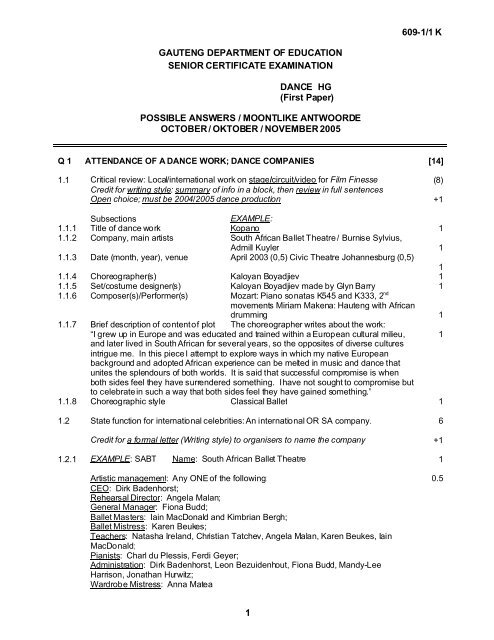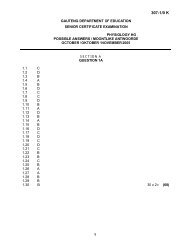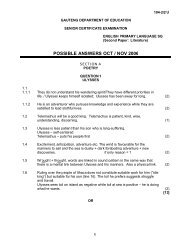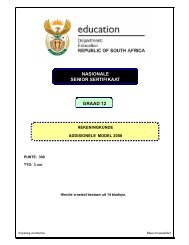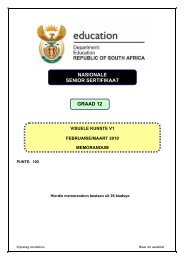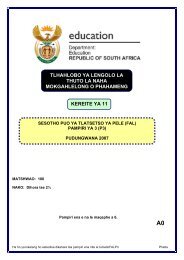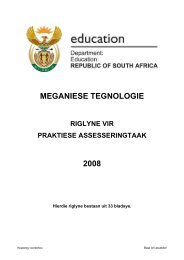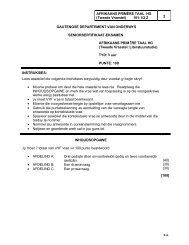View Paper - Gauteng Shared Service Centre
View Paper - Gauteng Shared Service Centre
View Paper - Gauteng Shared Service Centre
Create successful ePaper yourself
Turn your PDF publications into a flip-book with our unique Google optimized e-Paper software.
GAUTENG DEPARTMENT OF EDUCATION<br />
SENIOR CERTIFICATE EXAMINATION<br />
1<br />
DANCE HG<br />
(First <strong>Paper</strong>)<br />
POSSIBLE ANSWERS / MOONTLIKE ANTWOORDE<br />
OCTOBER/ OKTOBER / NOVEMBER 2005<br />
609-1/1 K<br />
Q 1 ATTENDANCE OF A DANCE WORK; DANCE COMPANIES [14]<br />
1.1 Critical review: Local/international work on stage/ circuit/video for Film Finesse<br />
Credit for writing style: summary of info in a block, then review in full sentences<br />
(8)<br />
Open choice; must be 2004/2005 dance production<br />
+1<br />
Subsections<br />
1.1.1 Title of dance work Kopano 1<br />
1.1.2 Company, main artists South African Ballet Theatre / Burnise Sylvius,<br />
Admill Kuyler 1<br />
1.1.3 Date (month, year), venue April 2003 (0,5) Civic Theatre Johannesburg (0,5)<br />
1<br />
1.1.4 Choreographer(s) Kaloyan Boyadjiev 1<br />
1.1.5 Set/costume designer(s) Kaloyan Boyadjiev made by Glyn Barry 1<br />
1.1.6 Composer(s)/Performer(s) Mozart: Piano sonatas K545 and K333, 2 nd<br />
EXAMPLE:<br />
movements Miriam Makena: Hauteng with African<br />
drumming 1<br />
1.1.7 Brief description of content of plot The choreographer writes about the work:<br />
“I grew up in Europe and was educated and trained within a European cultural milieu,<br />
and later lived in South African for several years, so the opposites of diverse cultures<br />
intrigue me. In this piece I attempt to explore ways in which my native European<br />
background and adopted African experience can be melted in music and dance that<br />
unites the splendours of both worlds. It is said that successful compromise is when<br />
both sides feel they have surrendered something. I have not sought to compromise but<br />
to celebrate in such a way that both sides feel they have gained something.”<br />
1<br />
1.1.8 Choreographic style Classical Ballet 1<br />
1.2 State function for international celebrities: An international OR SA company. 6<br />
Credit for a formal letter (Writing style) to organisers to name the company<br />
1.2.1 EXAMPLE:<br />
SABT Name: South African Ballet Theatre 1<br />
Artistic management: Any ONE of the following: 0.5<br />
CEO: Dirk Badenhorst;<br />
Rehearsal Director: Angela Malan;<br />
General Manager: Fiona Budd;<br />
Ballet Masters: Iain MacDonald and Kimbrian Bergh;<br />
Ballet Mistress: Karen Beukes;<br />
Teachers: Natasha Ireland, Christian Tatchev, Angela Malan, Karen Beukes, Iain<br />
MacDonald;<br />
Pianists: Charl du Plessis, Ferdi Geyer;<br />
Administration: Dirk Badenhorst, Leon Bezuidenhout, Fiona Budd, Mandy-Lee<br />
Harrison, Jonathan Hurwitz;<br />
Wardrobe Mistress: Anna Matea<br />
+1
2<br />
609-1/1 K<br />
Lead dancers: Any ONE of the following: 0.5<br />
Kimbrian Bergh, Karen Beukes, Anya Carstens, Iain MacDonald,<br />
Angela Malan, Burnise Sylvius, Christian Tatchev, Andries Weidemann.<br />
1.2.2 Brief history (Answers are open-ended; Other facts can also be relevant.)<br />
The SABT was founded after the regional arts councils, PACT Ballet Company and The<br />
State Theatre Ballet were phased out. The SABT, now located at the Nelson Mandela<br />
Theatre (former Civic Theatre) in Johannesburg aims, amongst others, to build on the<br />
foundations laid by generations of dancers and artists, to retain a high technical standard,<br />
to build a wide repertoire, to work with local and international choreographers and to train<br />
dancers. Since 1995, the SABT has run outreach programmes in Mamelodi, Alexandra<br />
and Kahtlehong, sponsored by the Anglo American Chairman’s Fund, De Beers Fund<br />
and Standard Bank. In 2002 the South African Ballet School was started. The school<br />
teaches classical ballet according to the RAD method as well as contemporary dance<br />
1<br />
and offers body conditioning classes.<br />
Choreographic style (Other facts can also be relevant.)<br />
Ballet (also referred to as ‘classical dance’). Evidence of this style seen in the stance,<br />
turn-out, placing (alignment, épaulement), balance, use of the head, legs, feet, arms and<br />
body according to certain rules, the transference of weight, lifts, the five positions of the<br />
feet, co-ordination in dance, the creation of an illusion of weightlessness and<br />
effortlessness, the grooming of the dancers, the point-work, the tutus, etc.<br />
1<br />
1.2.3 Repertoire (Other productions can be mentioned.) Titles of TWO works, e.g. 2003:<br />
Papillon, Hamlet; 2004: Kopano, Who Cares, Schlager<br />
2<br />
Q2 DANCE VOCATIONS [10]<br />
Copy and complete table. Job related to each area (5) + Responsibilities of each (5)<br />
Open-ended answers. Possible answers + mark allocation:<br />
Areas of employment A job related to each Responsibilities<br />
Entertainment Industry Producer/Director (1) To audition dancers and produce/direct a dance<br />
show (1)<br />
Journalism Reporter (1) To attend productions and report objectively (1)<br />
Dance Education Dance Teacher (1) To facilitate and assess learning experiences (1)<br />
Dance Administration Administrator (1) To capture and update data regularly and correctly<br />
(1)<br />
Dance Therapy Physiotherapist (1) To treat dance injuries without causing more<br />
damage (1)<br />
Q3 DANCE IN PERSONAL LIFE AND THE COMMUNITY [14]<br />
3.1 ONE social issue: HIV/Aids / Drug prevention/ Crime prevention.<br />
Is it necessary for dancers to be involved? Substantiate in a short paragraph.<br />
Open-ended answers; learners’ own account. Possible mark allocation:<br />
A professional, convincing writing style is required.<br />
(3)<br />
Issues such as HIV/Aids, drug abuse, crime, rape, hijacking, armed robbery, etc. can also affect<br />
dancers. (1)<br />
Dancers must be involved in social issues – it is a social responsibility (1). Dancers can get involved in<br />
- making people aware of the origin and impact of these abuses on individuals and families by<br />
spreading information through shows, brochures, etc. (1)<br />
- informing an audience about leading a healthy life style to prevent HIV/Aids, drug abuse, etc (1)<br />
- planning projects to keep street children (potential criminals) off the street (1)<br />
- organizing on-going activities in creative movement, regular dance performances, etc. (1)<br />
- turning potential criminals into creative individuals leading who lead a healthy life-style (1)<br />
- developing entrepreneurial skills in the community by which an income could be generated<br />
- promoting healing in the community (1)
3<br />
609-1/1 K<br />
3.2 What is creative movement? Why is it of value in schools? (5)<br />
Dance Creative Movement provides learners with the opportunity to:<br />
•<br />
•<br />
•<br />
•<br />
•<br />
•<br />
•<br />
•<br />
•<br />
•<br />
Develop an understanding and appreciation of dance<br />
Experience dance as a cultural art form in its own right<br />
Develop movement as a means of communication<br />
Gain an understanding and tolerance of cultural diversity through experiencing the<br />
dance forms of many different cultures.<br />
Increase listening skills, concentration, co-ordination and focus<br />
Encourages the maintenance of a healthy body and mind and the development of<br />
gross and fine motor activities<br />
Stimulate creative potential and imagination<br />
Become proficient in problem solving, decision making and negotiating skills,<br />
through group and social interaction<br />
Promote an awareness of all related aspects of dance, e.g. composing, performing,<br />
appreciating, teaching, researching or documenting...<br />
Use the creative movement teaching methodology in other areas of the curriculum<br />
such as in mathematics and language. Learn through doing,<br />
not just watching,<br />
saying and hearing.<br />
3.3 Produce and direct a dance show in community. List steps to plan this.<br />
Open-ended answers; learners’ own account. Possible mark allocation:<br />
Facts relating to the following can be considered; other relevant aspects could also be<br />
correct:<br />
Organizing committee/Venue/Date (1)<br />
Budget/Funding(1)<br />
Planning/Liaison (1)<br />
Programme/Auditions (1)<br />
Costumes/Décor/ Lighting/Music (1)<br />
Marketing/Advertising (1)<br />
Stage/Foyer/Refreshments management (1)<br />
(6)<br />
Q4 DANCE STYLE / FIELD OF DANCE Market your favourite dance form/field [14]<br />
E.g. - African Dance - Dance Composition (Choreography)<br />
Choose - Ballet - Folk Dance (Character National)<br />
- Jazz<br />
- Latin American<br />
Dancing<br />
ONE of: - Ballroom Dancing - Greek Dance (Ginner method) - Spanish Dance<br />
- Contemporary<br />
dance<br />
Indian Dance (North OR South) - Tap Dance<br />
• ARTICLE for school yearbook + Eye-catching HEADING for the article<br />
Eye-catching (creative) heading (0.5) Writing style, e.g. intro; body; conclusion (0.5)<br />
(1)<br />
• History, background or origin of dance form/field (introduction). Open-ended, e.g.<br />
Example:<br />
Ballet (or Classical Dance):<br />
Ballet or classical dance is one of the oldest styles of dance (a dancing statue was found in<br />
Egyptian times).<br />
King Louis XIV was one of the first ballet dancers; high-heeled shoes; Marie Taglione: pointe<br />
shoes, tutu, etc.<br />
Through the years an extensive repertoire has been created, including story ballets and<br />
abstract ballets.<br />
A variety of music can be used to accompany ballets, including folk, medieval, classical,<br />
romantic, jazz, etc.
,,<br />
4<br />
609-1/1 K<br />
• Principles which underpin the dance form (4)<br />
1 Stance: Position taken; standing correctly<br />
2 Turn-out: Rotary motion to view<br />
3 Placing: Arranging things in their proper place to achieve an ordered balanced from<br />
3.1 Alignment: Bringing into line, especially bringing three or more points into line<br />
3.2 Epaulement: and/or legs, the extent of which must be finely judged, but which will<br />
depend on the context.<br />
4 Laws of balance: A counterpoise (or things) in order to maintain equilibrium. Conforms to<br />
other basic rules, i.e.<br />
5 The basic rules of classic technique: These include Rules of the Head, Legs, Arms and Body<br />
6 Transference of weight: To convey or hand over one thing or person to another place or<br />
person. These include:<br />
6.1 The five positions of the feet<br />
6.2 The five jumps; From: 2 feet to 2 feet; 2 feet to 1 foot; 1 foot to 2 feet; 1 foot to the<br />
other; all on one leg<br />
7 Co-ordination: To bring proper parts into proper relationship<br />
The seven movements of dance: Plier (to bend). Étendre (to stretch), Relever (to rise). Sauler (to jump)<br />
Élancer (to dart), Glisser (to glide), Tourner (to turn)<br />
• Famous performer (career and achievements) – an open choice; check carefully if facts<br />
are correct incorporate an Internet search to verify facts.) Example:<br />
Any FOUR facts<br />
listed below<br />
(4)<br />
Baryshnikov, Mikhail Nikolayevich Soviet-born dancer, noted for his technical prowess and engaging<br />
stage personality. (1) Born in Riga (in present-day Latvia) in 1948 (1), Baryshnikov studied ballet since<br />
age 15 in Riga and in Leningrad (1), joining the Kirov Ballet (now the Saint Petersburg Ballet) in 1967<br />
(1). As a soloist and later as a principal dancer with the Kirov, he appeared in classical ballets setting<br />
new standards for technical virtuosity. (1) He also created roles in newly choreographed ballets, (1)<br />
including Vestris (1969), Hamlet (1970), AND The Creation of the World (1971). (1) Baryshnikov<br />
defected to the West in 1974 while touring Canada with the Bolshoi Ballet. (1) He later danced primarily<br />
with the American Ballet Theatre (1) (serving as its director from 1980 to 1989) (1) and the New York<br />
City Ballet. (1) Baryshnikov performed in a broad array of works, from classical ballets to more modern<br />
dance roles, (1) employing a range of styles for works by such choreographers as George Balanchine, a<br />
Russian-born American, (1) American Twyla Tharp (1) and Jerome Robbins (1) e.g. Don Quixote (1),<br />
Who cares (1), Apollo (1) etc.<br />
In 1990, with American choreographer Mark Morris, Baryshnikov founded a modern dance company,<br />
the White Oak Dance Project. (1) The group initially performed only works by Morris, but then<br />
expanded its repertoire to include choreography by Robbins; Tharp; Merce Cunningham and Kevin<br />
O’Day, from the United States; German-American Hanya Holm; and Joachim Schlömer, from Germany.<br />
(1) As an actor, Baryshnikov has appeared in motion pictures such as The Turning Point (1978), for<br />
which he was nominated for an Oscar (1) and White Nights (1985) (1), and in a play, Metamorphosis<br />
(1989) (1), based on a story by Kafka. He is often chosen as host for documentaries, e.g. the ABC<br />
television special, Baryshnikov on Broadway.<br />
(1) In 2004 he starred in a number of episodes in the TV<br />
series Sex and the City.<br />
(1)<br />
• Relevance of the dance form / field of dance today (conclusion)<br />
Learners’ own account / Open-ended answers, e.g.<br />
Diverse cultural groups enjoy Ballet - as performers on stage and/or as audience-goers.<br />
It is an internationally recognized dance form and is used in the art and commercial world.<br />
Ballet training in early life can later serve as a basis for any other dance style or field of dance.<br />
Many choreographers combine ballet with dance forms such as tap, African, folk, jazz, etc. in<br />
fusion works.<br />
(2)
5<br />
609-1/1 K<br />
Q5 CHOREOGRAPHERS Choose ONE from Guideline Document<br />
[14]<br />
To introduce ONE SA choreographer to the audience at the FNB Dance Umbrella.<br />
OPEN CHOICE: Example and possible mark allocation. Choose ONE:<br />
Cekwana, Cranko, Glasser, Gorden, Hawkins, Mantsoe, Matamela, Maqoma, Orlin, Paeper,<br />
Pather, Semela, Staff<br />
To be done as CUE CARDS (1 extra for intro and cue card style – if mark total allows.)<br />
5.1 Name of Dance Career (3)<br />
EXAMPLE: Robyn ORLIN<br />
± 25 years’ experience: Dancer, performer, choreographer, producer, teacher, artist<br />
Training and degrees in Arts Education:<br />
1991-93 Master in Fine Arts – Chicago<br />
1985: Laban School, University of London<br />
1975- 79: London School of Contemporary Dance<br />
1965- 72: RAD (London) Grades and Diplomas<br />
5.2 Achievements and Awards (4)<br />
2002: Laurence Olivier Award (London): Most Outstanding Achievement in Dance for daddy<br />
2000: Jan Faber Award (Paris) for Most Subversive Choreography for daddy (see full title below)<br />
1996: Special Award: Contribution to Contemporary Dance in SA<br />
1985- 1998: Five FNB Vita Choreography Awards<br />
5.3 Choreographic style and THREE examples of dance works (4)<br />
Choreographic style (1):<br />
ONE fact, e.g. post-modernism; contemporary dance; integration of multi-media, etc.<br />
Three works (3):<br />
2001: we must eat our suckers with the wrappers on (FNB Dance Umbrella; 2003 to France and<br />
Germany)<br />
1998: the future may be bright but it’s not necessarily orange (2002: Montpellier Dance Festival,<br />
France)<br />
1998: daddy I’ve seen this piece six times before and I still don’t know why they’re hurting each<br />
other (SA, France, The Netherlands, Norway, Greece, Sweden)<br />
1997: ubu and the truth commission (multi-media production with Kentridge and handsprung<br />
puppets)<br />
1995: naked on a goat (Market Theatre Jhb, Poland, Switzerland, Germany)<br />
1993: upsy-daisy (solo; Blue Rider Theatre, Chicago, Art Institute of Chicago)<br />
5.4 Additional interests and current involvement (3)<br />
Related Experience (± 1 or 2)<br />
- Choreographic workshops nationally and internationally (Japan, Greece, Paris)<br />
- Teacher at NSA (1998-2001), PACT Dance Co (1988-89), Market Theatre Laboratory<br />
(1996-2003)<br />
Inaugurated dance departments: Funda Art <strong>Centre</strong>, Soweto; FUBA (Federated Union of Black<br />
Artists)<br />
Guest choreographer: France, Holland, Germany<br />
Current involvement (± 1 or 2)<br />
2004: the babysitting series...part 2 (Jhb Art Gallery, FNB Dance Umbrella). Originated in 2000:<br />
babysitting caspar<br />
in collaboration with guards: Der Alten Nationalgalerie, Berlin, funded by the<br />
Hauptstadtkulturfonds. An on-going project; will happen over next few years in museums around<br />
the world to culminate in a final presentation, still undecided.
6<br />
609-1/1 K<br />
Q6 DANCE WORKS Compare TWO works with bird images Examples<br />
[14]<br />
Swan Lake (1877) The title refers to swans (birds) (1) The title means “The Birds” (1)<br />
Choreographers: Petipa: Acts 1,3, Ivanov: Acts 2,4 (0,5) Choreographer: Vincent Sekwati Mantsoe (0,5)<br />
Characters Odette (the Swan Princess, Siegfried (prince), Characters: 5 dancers (from not<br />
Rothbart (magician) Odile (his daughter) (0,5)<br />
identified by name; they remain anonymous “birds”<br />
(0,5)<br />
Music: Peter llyich Tchaikovsky (0,5) Music: Gabrielle Roth (0,5)<br />
Storyline/Plot (± 2) Swans feature prominently. The historical background of (± 2)<br />
Prologue Odette and friends gather flowers in the Vincent Mantsoe was one of the first students of<br />
forest.<br />
the groundbreaking Moving Into Dance’s<br />
Rothbart, the evil sorcerer, transforms them into Teachers’ Training Course in 1992. Students<br />
swans.<br />
were required to choreograph solos at the end of<br />
Act1 Prince Siegfried is celebrating with his friends. each year and Vincent decided to choreograph<br />
His mother (Queen) gives him a silver crossbow. an untitled solo which generated a lot of interest.<br />
She reminds him that he must soon choose a bride. Vincent’s solo included elements of “bird-like”<br />
Siegfried sees a flock of swans; he goes to hunt movements. Two years later (1994) he<br />
them.<br />
choreographed the actual solo. The work was<br />
Act 2 Prince Siegfried with swans at the lake nominated for the FNB Choreography Award. In<br />
As he watches, they regain their human form. 1996 it was extended to a group piece and won<br />
Odette tells Siegfried of the spell: They are maidens two 1<br />
only at midnight. Only the love of a man can free<br />
them. The prince falls in love with Odette and vows<br />
he will release her from the magician’s spell.<br />
Rothbart, watching from the shadows, is determined<br />
to force the Prince to break his vow.<br />
Act 3 The court celebrates Siegfried’s coming of age<br />
No specific bird images in this act, except when<br />
Odile appears (disguised as Odette) wearing black.<br />
Odette appears (in white) as an image in a window.<br />
Act 4 At the lake<br />
The swan maidens’ hope of being free of the<br />
magician’s spell is destroyed by Siegfried’s betrayal<br />
of Odette. Odette appears (in white) as an image in<br />
a window. Siegfried begs Odette’s forgiveness and<br />
vows his love. The sorcerer conjures up a storm.<br />
Siegfried fights him, tears off a wing and breaks the<br />
sorcerer’s spell. Odette resumes her human form<br />
and is united with Siegfried in eternal happiness.<br />
st prizes in Angola and France:<br />
1 st prize in Luanda (Angola) at the 1 st<br />
Dance Encounters of Contemporary African<br />
Dance and<br />
1 st prize in Seine-Saint-Denis (France) at<br />
the 5 th Gule Matari (1994)<br />
Moving Into Dance –<br />
Gula Matari<br />
•<br />
•<br />
International Choreography<br />
Competition<br />
Influences (± 2): According to Mantsoe: “The<br />
‘Spirits’ or ‘Ancestors’ are an important part of<br />
his creative process. He performs a ritual at<br />
least twice a year for two reasons:<br />
1. to be reminded of important rules from the<br />
Ancestors<br />
2. to ask respectfully for permission to ‘borrow’<br />
some of the traditional movements, i.e. the<br />
sacred ones which may not be performed in<br />
public<br />
Mantsoe thus re-connects with his roots: He<br />
tries to share his childhood experiences of his<br />
interaction with Nature, the fables told by his<br />
grandmother and the rituals of his mother and<br />
aunt who are sangomas (traditional healers).<br />
The work was influenced by Mantsoe’s love of<br />
nature and its inhabitants, in this case, birds –<br />
how they move, the sounds they make and how<br />
they relate to each other.<br />
Costumes (± 1) Costumes in Acts 2 and 4 imitate<br />
swans: Swans maidens: white tutus, feathers on<br />
heads. Odette wears white (good); Odile (Act 3)<br />
wears black (evil).<br />
Rothbart (evil magician) has wings.<br />
Set design (± 1) When the swan maidens are<br />
prominent, the décor depicts a forest by a lake (Acts<br />
2 and 4)<br />
Costumes (± 1) Initially a T-shirt; later all<br />
dancers wear feathers. Designer: Vincent<br />
Sekwati Mantsoe<br />
Set design (± 1) No specific décor is used. The<br />
vast stage is left to the imagination of the<br />
audience.
Choreographic style (± 1) The movements of<br />
Odette and the swan maidens imitate the<br />
movements of swans - bent floor position with<br />
crossed arms, fluttering arms. The large group of<br />
swans ( corps de ballet)<br />
move perfectly together.<br />
Rothbart’s movements are big and intimidating –<br />
his big wings (attached to his arms) flutter<br />
ferociously.<br />
7<br />
609-1/1 K<br />
Q7 MUSIC THEORY [12]<br />
Q8 RUDIMENTS OF MUSIC<br />
Choreographic style (± 1) Mantsoe changes each<br />
dancer into a bird-being. Prominent movements:<br />
Arm movements imitate the motion of how birds<br />
fly; Back contractions; Head movements – chirpy<br />
and abrupt; Disjointed and staccato gestures;<br />
Stillness; Simplicity. Group formation resembles<br />
larger bird species.<br />
7.1 Andante = At a walking pace. (1)<br />
7.2 4/4 time signature = Four crotchets in a bar OR Simple quadruple time (1)<br />
7.3 Espress. Espressivo (0.5) Expressively (0.5) (1)<br />
Dim. Diminuendo (0.5) Getting gradually softer (0.5) (1)<br />
7.4 Play the bar one octave higher. (1)<br />
7.5 Minim (1), Dotted semiquaver (1), Demisemiquaver (1) (3)<br />
7.6 Quaver rest (1), Crotchet rest (1), Minim rest (1), Semibreve rest (1)<br />
(NB: Rest symbols must coincide with answers.<br />
Match the information in Column B with that in Column A.<br />
Write the correct alphabet letter next to each number. Example 8.13 C<br />
COLUMN A COLUMN B<br />
8.1 Chordophone G (Violin)<br />
8.2 Trombone K/E (Brass) OR (Aerophone)<br />
8.3 Forte<br />
F (Loud)<br />
8.4 Oboe E (Aerophone)<br />
8.5 Beat D (Pulse)<br />
8.6 Melody and accompaniment M (Homophonic)<br />
8.7 Polyphonic I (Two melodies)<br />
8.8 Marimba O (Idiophone)<br />
8.9 Gradually softer N (Decrescendo)<br />
8.10 Two-part form L (AB)<br />
8.11 High pitch A (Soprano)<br />
8.12 ABACA B (Rondo Form)<br />
[12]<br />
Q9 MUSIC STYLES Choose TWO music styles<br />
(African, Impressionism, Jazz, Nationalism, Romanticism)<br />
[12]<br />
9.1 TWO Characteristics of each style (melody, rhythm, dynamics, tone colour,<br />
harmony)<br />
9.2 TWO musicians (performers/composers) from each style period<br />
(4)
9.3 TWO works from each style period<br />
Example of a possible answer (NB: Other answers may also be correct. Check<br />
carefully.)<br />
IMPRESSIONISM JAZZ<br />
9.1 Rhythm: Avoidance of a recurring strong<br />
pulse which coincides with bar lines;<br />
flexible rhythm reflects the characteristic<br />
unaccented quality of French Language<br />
Tone colour: e.g. in Debussy’s music:<br />
Unusual registers for instruments<br />
Strings and brasses often muted<br />
Tremolos on strings and harp<br />
Tone colour used to create atmosphere<br />
9.2 Any TWO of the following: Debussy, Ravel,<br />
Respighi, Delius, Satie, Monet, Renoir,<br />
Mallarmé, Verlaine, etc.<br />
Q10 COMPOSERS Choose ONE composer.<br />
(Adam, Tchaikovsky, Naidoo, Satie, Stravinsky, Roth)<br />
Write brief notes for a website: Career, Music style, Repertoire for dance<br />
e.g. TCHAIKOVSKY (1840 - 1893) Example and possible mark allocation:<br />
8<br />
Rhythm: In ragtime the left hand keeps the<br />
constant two-beats-in-a-bar while the right<br />
hand plays off- beats and syncopations.<br />
Tone colour: Unique to each jazz style, e.g.<br />
Ragtime: piano; Dixieland: 5-8 players,<br />
namely<br />
• Front line (trumpet/cornet, clarinet,<br />
trombone);<br />
• Chordal line (piano/banjo/guitar);<br />
•<br />
Drums and a low instrument<br />
(tuba/bass)<br />
Any TWO of the following: Joplin,<br />
Armstrong, Smith, Brubeck, Ellington,<br />
Davis, Monk, Fitzgerald, etc.<br />
609-1/1 K<br />
9.3 Any TWO works, e.g. Clair de lune Any TWO works, e.g. Unsquare dance (4)<br />
L’aprés-midi di’un faune La Mer Hotter than that Lost your head blues<br />
Career (± 4)<br />
Age 21: Began studying music St Petersburg Conservatory; Progressed rapidly. Harmony professor<br />
Moscow Conservatory.<br />
Age 30: Many works: an opera, a tone poem, a symphony and an orchestral work Romeo and Juliet.<br />
1877: Acquired benefactress Nadezhda von Meck, She gave annuity. He quit position and only<br />
composed. They never met. After 14 years she stopped support. He was hurt. Tchaikovsky<br />
conducted his works and gained respect throughout Europe.<br />
1891: To New York to participate in inauguration of Carnegie Hall – 4 concerts. Also 2 concerts of his<br />
music in Baltimore and Philadelphia. 1893: Conducted premiere of Symphony No 6, Pathétique. Nine<br />
days later he died aged 53.<br />
Music style (± 5)<br />
Melody Lyrical melodies; Signature tunes refer to characters, e.g. Swan Lake (Odette, Siegfried,<br />
Rothbart).<br />
Regular 4- and 8- bar phrases as well as long, irregular phrases; Repeated melodies -<br />
easily sung<br />
Tone colour Large orchestras; Striking contrasts; Strings prominent in melodic lines; Woodwind and<br />
brass alternate; Special tone colour effects to create images, e.g. the various dances in<br />
The Nutcracker (celesta: Dance of Sugar Plum Fairy; piccolo: Chinese dance;<br />
woodwinds: Arabian dance; flutes: Dance of reed pipes, etc.)<br />
Dynamics Extremes and sharp contrasts of dynamics; Soft, lyrical passages, full of passion;<br />
Sometimes outcries with louder dynamics and fuller orchestration.<br />
Pulse, Rhythm, Tempo Great variety of metres and rhythmic patterns; Metres sometimes changed<br />
within movements; Sharp contrasts in tempo occur.<br />
Tonality Harmony: Major and minor tonality, often alternating; Chromatic notes extensively; Mild<br />
dissonances.<br />
(2)<br />
(2)<br />
(4)
Contribution to dance repertoire (± 3) Romantic ballets: The Nutcracker, Swan Lake,<br />
Sleeping Beauty.<br />
9<br />
609-1/1 K<br />
Texture Mostly homophonic textures; Sparse textures, e.g. romantic passages ( pas de deux)<br />
-<br />
solo instruments. Dense textures and vast orchestration in dramatic scenes.<br />
Q11 DANCE TYPES Choose THREE<br />
[12]<br />
Barcarole, Bolero, Cha-cha, Charleston, Flamenco, Foxtrot, Galop, Habañera, Kwela,<br />
Mambo, Mazurka, Mbaqanga, Minuet, Polka, Polonaise, Ragtime, Rumba, Samba,<br />
Tango, Tarantella, Waltz<br />
11.1 Write next to each dance: Tempo, Time signature, Country of origin<br />
An open choice, e.g.<br />
Dance type Tempo Time signature Country of origin<br />
Ragtime Moderate 2<br />
4<br />
America (3)<br />
Waltz Moderate/Fast 3<br />
4<br />
Austria (3)<br />
Tango Moderate 4<br />
4<br />
Argentina (3)<br />
11.2 Choose ONE of the above. Exercise in a dance class. Open-ended answers. (3)<br />
Example: TANGO<br />
•<br />
•<br />
•<br />
To reinforce the count of four beats in a bar (simple quadruple): strong-weak-medium-weak<br />
To inculcate the subdivision of four beats in a bar according to the typical tango rhythm<br />
To interpret the dramatic-sensual style correctly when performing the Latin-American dance


